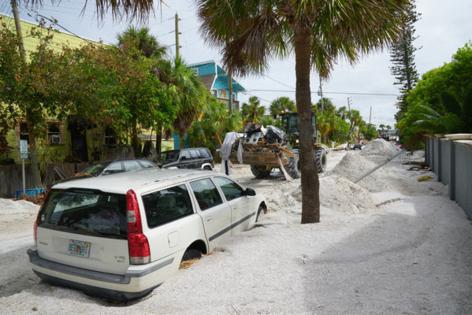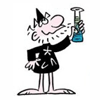How strong can Cat 5 Milton get? This hurricane may approach the maximum limit
Published in News & Features
No matter how perfect conditions may get, a hurricane can only get so strong.
At least that’s what the science says. Milton, which blew up into a Category 5 hurricane Monday and kept going, is pushing the boundaries, approaching what’s known among hurricane experts as the Maximum Potential Intensity or MPI. When meteorologists pull out that measure, you know the hurricane is a monster — and Milton is that. At 5 p.m., the National Hurricane Center said its sustained winds had hit 180 mph.
How strong can it get? The next day or so will tell.
The top-end hurricane is feeding on a seemingly bottomless buffet of record or near-record hot waters in the Gulf of Mexico, which weren’t cooled much by the passage of Hurricane Helene less than two weeks ago. It has friendly winds and not much land in sight, unless it edges closer to the northern end of the Yucatan peninsula.
That puts the glass ceiling of MPI for Milton at around 195 mph, with an atmospheric pressure near 900 MB, said Tomer Burg, a researcher with the National Weather Service’s Weather Prediction Center,
“At this point, for Milton’s short term forecast, we need to bring its maximum potential intensity (MPI) into the discussion,” he wrote on Twitter Monday afternoon.
Several experts echoed Burg as they watched Milton shoot from a tropical storm with 60mph winds on Sunday morning to a Category 4 with 150 mph winds — then a Cat 5 above 155 and climbing. On satellite images, it was the the very definition of a powerful hurricane, with a tight pin-hole-sized eye.
By barometric pressure — a measure of storm intensity — Milton has already entered the top 10, tying with two other storms at No. 8 on the all-time list. As far as Gulf of Mexico storms, only Hurricane Wilma in 2005 had a higher recorded wind speed — at 185 mph — before weakening. Milton could still get there. The latest forecast calls for Milton to max out at 185 mph sustained winds.
“I think it’s close. It’s not quite there,” said Brian McNoldy, a senior research associate at the University of Miami’s Rosenstiel School of Marine, Atmospheric and Earth Science.
The maximum potential intensity represents a theoretical speed limit, he said. Storms can reach and even surpass it, but that’s rare and difficult. Usually, other factors slow down storms before they can hit their ultimate speed.
“In reality, storms never get to this theoretical maximum because there’s something else getting in the way,” said Jake Carstens, assistant professor in the Department of Atmospheric Sciences at the University of North Dakota. “In this case, we’re pretty close. The Gulf of Mexico has one of the most favorable environments out there for a hurricane.”
But some speed bumps could be ahead and the hope — especially for residents along Florida’s already battered Gulf Cost — is that Milton will weaken before landfall.
“One of the things that might get in its way is the proximity of land. It’s getting fairly close to the Yucatan, which could make its list of perfect conditions a little shorter,” McNoldy said. “Yucatan will be kind of a hiccup for it. That’s not really the main player.”
A pocket of storm-shredded wind shear closer to Florida, in particular, is what forecasters at the National Hurricane Center are counting on to pump the brakes on Milton, bringing it down to a Category 3 before landfall.
One thing that helped Milton’s rapid strengthening is its size. It’s a small hurricane, which means it can spin up — or down — much quicker than a larger storm like Helene that passed through the same waters. And it’s expected to shoot over the Gulf of Mexico at a pretty good clip, leaving little time for it to churn through the hotter water at the sea’s surface and reveal the slightly colder waters below, which could slow down a strengthening storm.
The big thing forecasters are watching that could crack down Milton’s winds is called an eyewall replacement cycle, when a powerful hurricane develops a second, bigger eye that chokes off some of the energy from the main eye. That can take the top edge off a hurricane but can also expand its damaging wind field.
“The outer eyewall taps some of the energy and kind of steals it from the innermost intense eye, causing temporary expansion of the eye and weakening of the winds of a storm,” said Brian Soden, a professor of atmospheric sciences at the University of Miami’s Rosenstiel School of Marine, Atmospheric and Earth Science.
“Hopefully it goes through one right before landfall,” he said.
Climate change impacts
Until that happens, Hurricane Milton will likely continue to strengthen, potentially even to its maximum potential intensity, as set by the steamy waters of the Gulf.
MPI can also be impacted by climate change. In the future, warming world could push that potential upper limit even higher, producing even stronger storms.
That’s because the formula for determining how strong a storm could theoretically get involves sea surface temperature. If hotter waters goes into the equation, the chance for a storm to get even stronger rises, said Carstens.
“With warming oceans, the ceiling and the potential for a storm to really tap into its fuel source is increasing,” he said. “If anything, we’re raising the ceiling.”
In the latest Intergovernmental Panel for Climate Change report, top global researchers agreed they had high confidence that peak wind speeds for the strongest storms will increase as the planet warms.
This could also be a factor in how many storms get so strong, so fast in a process known as rapid intensification.
“Observations have shown an increase in the number of storms that undergo rapid intensification over the last 40 years,” Soden said.
However, he added, scientists believe that climate change may actually result in fewer storms per year, but the storms that do form would be more likely to be powerful Category 4 or 5 hurricanes.
Even before humans burned enough fossil fuels to warm the planet, strong hurricanes have been a problem. The issue, experts say, is that climate change could load the atmospheric dice enough to make monster storms a more common problem.
The strongest hurricane on record to ever hit the continental U.S. was in 1935, when an unnamed hurricane slammed into the Florida Keys as a Category 5 storm with a minimum pressure of 892 mb. We don’t have records for how strong the winds were, just the low pressure at the heart of the storm.
The most powerful hurricane ever recorded anywhere in terms of sustained winds was Hurricane Patricia, which crashed into Mexico as a Category 5 storm in 2015. It had a minimum pressure of 872 mb and sustained winds topping 215 mph.
Hurricane Andrew, the storm of the century for many in South Florida, came in as a Category 5 with a minimum pressure of 922 mb and sustained winds that peaked at 165 mph.
Milton has already surpassed that.
©2024 Miami Herald. Visit at miamiherald.com. Distributed by Tribune Content Agency, LLC.







Comments